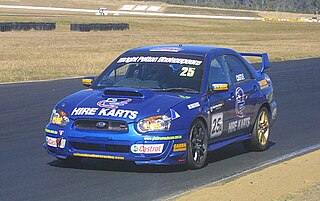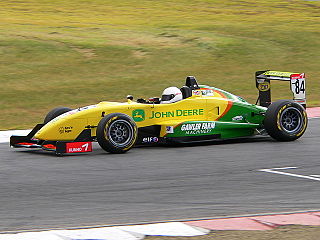
Formula Two is a type of open-wheel formula racing category first codified in 1948. It was replaced in 1985 by Formula 3000, but revived by the FIA from 2009–2012 in the form of the FIA Formula Two Championship. The name returned again in 2017 when the former GP2 Series became known as the FIA Formula 2 Championship.

Australian Formula 2, sometimes abbreviated to AF2 or ANF2, is a "wings and slicks" formula racing category in Australia. The category is one of Australia's oldest, dating back to 1964. The current format of AF2 was introduced in 1978. Brian Shead of Cheetah Racing Cars and Garrie Cooper of Elfin Sports Cars were largely responsible for the development of the format, which was devised to suit the needs of Australian drivers, most of whom had little or no sponsorship and had to bear the costs of racing out of their own pockets.
The Australian Drivers' Championship was a motor racing championship contested annually from 1957 to 2014 by drivers of cars complying with Australia's premier open-wheeler racing category as determined by the Confederation of Australian Motor Sport. From 2005 to 2014 this category was Formula 3 and the championship was promoted as the Formula 3 Australian Drivers' Championship. Each year, the winner was awarded the CAMS Gold Star. The title was revived in 2021 for the new S5000 category.
The Australian Formula Ford Championship is an Australian motor racing competition for drivers of Formula Ford racing cars, held annually since 1970. From 1970 until 1992 it was a national series and from 1993 until 2013 the series was sanctioned by the Confederation of Australian Motor Sport as the Australian Formula Ford Championship. From 2014 to 2018 it reverted to national series status. The Australian Formula Ford Championship name was then applied to the series by the Formula Ford Association from 2019.
The Australian Endurance Championship is an Australian motor racing title which has been awarded by the Confederation of Australian Motor Sport in numerous years and for numerous categories since 1981.
The Australian Production Car Championship is an Australian motor racing title for production cars, sanctioned by the Confederation of Australian Motor Sport (CAMS). The championship was first contested in 1987 and from 2008 to 2015 the title was awarded to the most successful driver in the annual Australian Manufacturers' Championship series which ran on the Shannons Nationals Motor Racing Championships program.
The Australian Super Touring Championship was a CAMS-sanctioned national motor racing title for Super Touring Cars.
The Australian One and a Half Litre Championship was a CAMS sanctioned national motor racing title contested annually from 1964 to 1968. It was open to drivers of cars complying with the Australian 1½ Litre Formula which specified open wheel racing cars fitted with unsupercharged engines using commercially available fuel and limited to 1500cc capacity. The title was staged over a single race in the first two years and over a series of races in the last three.

The Australian GT Championship is a CAMS-sanctioned national title for drivers of GT cars, held annually from 1960 to 1963, from 1982 to 1985 and from 2005. Each championship up to and including the 1963 title was contested over a single race and those after that year over a series of races. The categories which have contested the championship have not always been well defined and often have become a home for cars orphaned by category collapse or a sudden change in regulation.

Australian Formula 1 (AF1) was a motor sport category for open-wheeler racing cars which was current in Australia from 1970 to 1983.

The Australian National Formula was an Australian motor racing category which was introduced by the Confederation of Australian Motor Sport in 1964 and remained current until the end of 1969. It had replaced Formula Libre as the Australian premier racing formula.
The Australian GT Production Car Championship was a CAMS sanctioned national motor racing title, organised by Procar Australia Pty Ltd, for drivers of Group 3E Series Production Cars.
The 2008 Australian GT Championship was a CAMS sanctioned Australian motor racing competition for closed, production based sports cars which were either approved by the FIA for GT3 competition or approved by CAMS as Australian GT cars. It was the 12th Australian GT Championship to be awarded by CAMS. The Australian GT Sportscar Group Pty Ltd was recognised by CAMS as the Category Manager and Administrator for the 2008 championship.

Group 3E Series Production Cars is an Australian motor racing formula for production based cars competing with limited modifications. Group 3E cars formerly contested the Australian Manufacturers' Championship and Australian Production Car Championship titles and compete in the annual Bathurst 12 Hour and Bathurst 6 Hour endurance races.
The 1966 Australian Drivers' Championship was a CAMS sanctioned Australian motor racing title for drivers of racing cars complying with either the Australian National Formula or the Australian 1½ Litre Formula. The winner of the title, which was the tenth Australian Drivers' Championship, was awarded the 1966 CAMS Gold Star.

The 2006 Australian Drivers' Championship was a CAMS sanctioned national motor racing title open to Formula 3 cars. The title was contested over an eight-round, 16 race series, with the winner being awarded the 2006 CAMS Gold Star. The series was organised and administered by Formula 3 Australia Inc. and was officially known as the "2006 Khumo Tyres Australian Formula 3 Championship for the Australian Drivers' Championship". It is recognised by CAMS as the 50th Australian Drivers' Championship and as the 6th Australian Formula 3 Championship.
The 1985 Australian Sports Car Championship was a CAMS sanctioned motor racing title for drivers of Group A Sports Cars. It was the 17th Australian Sports Car Championship and the first to be run concurrently with the Australian GT Championship.
The 1986 Australian Sports Car Championship was a CAMS sanctioned Australian motor racing title for drivers of Group A Sports Cars. It was the 18th Australian Sports Car Championship.

Formula 4 Australian Championship Certified by FIA is an upcoming Australian motor racing series for open-wheel cars complying with FIA Formula 4 regulations. The inaugural championship, known as the CAMS Jayco Australian Formula 4 Championship, was organised from 2015 to 2019.

The 2015 CAMS Jayco Australian Formula 4 Championship was an Australian motor racing competition for Formula 4 cars. It was the inaugural Australian F4 Championship. It commenced on 10 July at the Townsville Street Circuit and ended on 6 December at the Homebush Street Circuit after seven events comprising three races each.

















